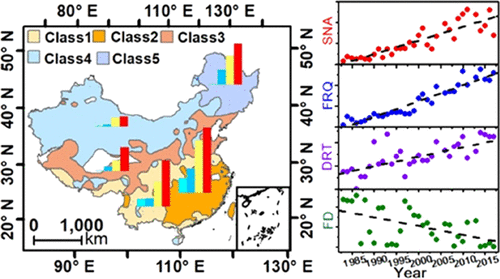当前位置:
X-MOL 学术
›
Environ. Sci. Technol.
›
论文详情
Our official English website, www.x-mol.net, welcomes your
feedback! (Note: you will need to create a separate account there.)
Climatic versus Anthropogenic Controls of Decadal Trends (1983–2017) in Algal Blooms in Lakes and Reservoirs across China
Environmental Science & Technology ( IF 10.8 ) Pub Date : 2021-02-17 , DOI: 10.1021/acs.est.0c06480 Kaishan Song 1, 2 , Chong Fang 1, 3 , Pierre-Andre Jacinthe 4 , Zhidan Wen 1 , Ge Liu 1 , Xiaofeng Xu 5 , Yingxin Shang 1 , Lili Lyu 1, 6
Environmental Science & Technology ( IF 10.8 ) Pub Date : 2021-02-17 , DOI: 10.1021/acs.est.0c06480 Kaishan Song 1, 2 , Chong Fang 1, 3 , Pierre-Andre Jacinthe 4 , Zhidan Wen 1 , Ge Liu 1 , Xiaofeng Xu 5 , Yingxin Shang 1 , Lili Lyu 1, 6
Affiliation

|
The proliferation of algal blooms (ABs) in lakes and reservoirs (L&Rs) poses a threat to water quality and the ecological health of aquatic communities. With global climate change, there is a concern that the frequency and geographical expansion of ABs in L&Rs could increase. China has experienced rapid economic growth and major land-use changes over the last several decades and therefore provides an excellent context for such an analysis. About 289,600 Landsat images were used to examine the spatiotemporal distribution of ABs in L&Rs (>1 km2) across China (1983–2017). Results showed significant changes in the temporal slope of the sum of normalized area (0.26), frequency (2.28), duration (6.14), and early outbreak (−3.48) of AB events in L&Rs across China. Specifically, AB-impacted water bodies expanded longitudinally, and the time range of AB observation has expanded starting in the 2000s. Spearman correlation and random forest regression analyses further indicated that, among climatic factors, wind speed and temperature contributed the most to AB expansion. Overall, anthropogenic forces have overridden the imprints of climatic factors on the temporal evolution of ABs in China’s L&Rs and therefore could inform policy decisions for the management of these resources.
更新日期:2021-03-02











































 京公网安备 11010802027423号
京公网安备 11010802027423号